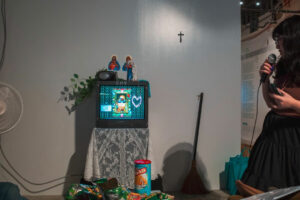from Developh.
THE PHILIPPINES is considered one of the most online populations in the world, its citizens leading in terms of internet use based on studies by Google and Bain & Co. Despite this, the country’s economy continues to lag, with Filipinos also considered to be one of the most exploited and disinformed populations in the world.
Chia Amisola, founder of critical technology project Developh, captures glimpses of societal repression and labor economies in a collection of net art, software, games, and literature by over 20 Filipino artists. These pieces are now contained in a karaoke-style exhibit at Space63 titled “Kakakompyuter Mo Yan!” (in English, “that’s what you get for being on the computer!,” a phrase a Filipino parent would often tell a child spending too much time online).
The exhibit was first presented at the Demo Festival in New York City in June. It is now on view in Makati’s Space63 until Sept. 21.
The exhibit explores what a Third World nation suffers in an extremely online state. It tackles data center mythologies, shady forums, and bootlegs of various media, speaking to the identities and narratives of Filipinos that inhabit and dwell within the internet.
Chia Amisola refers to this type of art as “Internet Ambient.”
“It’s an art that’s concerned with revealing the passive, default, and invisible elements of our technological oncologies, thus helping us return to humanity,” they explained in a talk at the launch of the exhibit. “I think a lot about preservation, performance, and how we gather on sites. I’m invested in the Third World — its loss, its love, its labor, and its liberation, and our infinite ability to draw countless new worlds of our own.”
With Developh and the Philippine Internet Archive, the work has involved engaging in new media arts and preserving digital movements and cultures in the hopes of using technology as a tool for good.
As an individual artist, Ms. Amisola has been exhibited in Berlin, San Francisco, London, Manila, and Toronto, with Forbes 30 Under 30 recognizing their potential in the field of art.
“What does the Third World get for being on the internet? Exploitation, labor, repression, and disinformation, but also liberation, community, self-preservation,” the artist said.
The works in “Kakakompyuter Mo Yan!” vary greatly, from Beatris Cabana’s generative piece recreating Filipino forums that discuss the abortion black market, to Mac Andre Orbaleta’s shrine to hacker Onel De Guzman, the Filipino responsible for the Love Bug virus back in 2000. Notably, Mr. De Guzman created the virus to steal wi-fi passwords so that he wouldn’t have to pay for the internet.
“When Filipinos make net art, we claw, we embed, we exploit. We’re erasing this impossible boundary between ourselves and technology that we’ve been enclosed around our whole lives,” said Developh’s Ms. Amisola, adding that Filipinos’ relationship with the internet is “a story of reclamation against its militant and imperialist underpinnings.”
For animator Agustin Crisostomo, whose contribution to the exhibit takes the form of a game, the strength of internet art is “its ability to feel very personal and familiar to the average Filipino.”
His work Alt-Tab is a game where one tries to inconspicuously click the alt-tab key to peek at naughty images while in a computer shop — an experience he himself had as a queer boy exploring his sexuality online, albeit at home. The goal is not to get caught doing this, as well as to get rid of the plethora of pop-up screens that appear while visiting the naughty sites.
“It’s easy to look back and find the comedy in these experiences that many of us had,” he told BusinessWorld. “I saw the open call from Chia and got the idea to do this. I’m glad they were willing to support it.”
At Space63, the exhibit can be accessed on a box television that displays all the net art pieces and software on a karaoke menu screen, and on a computer that looks just like the ones found in a Piso Net computer shop. Designed to look like a Filipino household’s old living room, the exhibit invites visitors to engage with the terminally online identity of modern-day Philippines.
For those who actually want to sing karaoke, the television has a fully functioning karaoke mode filled with instrumentals ripped off from YouTube.
The exhibit’s curator hopes Developh and its projects can connect with many Filipinos and provide a reflection of a familiar reality. “I think to preserve my nation as it has lived and died on the internet might be my life’s work,” they said.
“Kakakompyuter Mo Yan!” can be viewed from Friday to Sunday, 12 to 5 p.m., at Space63, Comuna, 238 Pablo Ocampo Sr. Ext., Makati City. It runs until Sept. 21. For more information, visit developh.org. — Brontë H. Lacsamana
